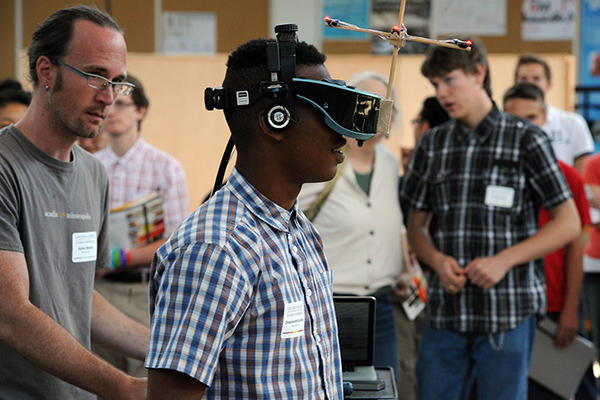Wearables
Google Glass
Google Glass caught much attention, topping news headlines in description of the field of modern Wearable technology. Initiated as the next step of augmentation in workplace tech tools, Glass is something that we didn't tread lightly.
At first glance, we saw it as a pair of glassless glasses. The single, small prism block was a distracting interruption the top-right corner of our view. Once it was turned on, however, the rapid blood flow of childhood-Christmas excitement ensued. It was incredible! With nothing but spoken commands it could run its apps, its Google searches, even its camera.
After a bit of practice, we discovered not only the use of the power button and swipes but also the camera button itself, which made it much easier to take videos with as well. The framing of Google Glass videos are on par with that of the GoPro, because of Glass' light weight and eyeglass-standard affixiation to its wearer.
In the end, a lot of struggles were duly noted as well. Google Glass had a disappointingly small battery life, and its limitations to secure WiFi access was rough at times. Our Explorer Edition Glasses were also unable to link to Apple iPhones.
Pebble Watch
We explored the various capabilities of Pebble Smartwatch by understanding its user group, audience, and purpose in a medical context. The group also interacted with the Pebble watch javascript (.JS) software package via CLOUDPEBBLE to practice developing an application as well as to further understand the structure of the applications that are used on Pebble Smartwatch.
Pebble Smartwatch allows users to track various aspects of their health such as heartrate, daily consumed calories, etc. – just by looking at your wrist!

Virtual & Augmented Reality
Google Cardboard
We tested Google Cardboard to learn about how it renders virtual reality (VR). When we say VR in this case, we define it as the means to view a digital 3-D image and navigate it via the interface of a responsive headset device. The higher its image quality and the more immediately responsive it is to, let's say, the turning of a head, the better the VR device's overall quality.
With the utilization of an Android smartphone, which we assume you have access to, Google Cardboard allows you to explore simulated environments and solve their world-altering puzzles.
Google Cardboard was also tested in order to compare its VR capabilities to those of the high quality Oculus Rift (OR) device. Cardboard is much more affordable than the OR, and with the right Android in the right setting, Cardboard can also manage to create stunning vistas.
Oculus Rift
The Oculus Rift is an amazing peice of growing technology. LATIS research center has allowed us to test and use their very own OR. It's a very expensive peice of equipment. We tested the OR for the value it has in changing perspective of the user and how that change could impact storytelling.
Right now, the OR is being developed and used in the video game industry, in which good story telling is a must. What we found in our research is that when you use a high level virtual reality device like the OR, it really tricks your mind into thinking you are really in this virtual world. Whether you're flying through the air or in the middle of a dark room in this virtual world, it creates a very believable experience.
The biggest difference between the Oculus Rift and Google Cardboard is price and accessiblity. Google Cardboard being about 15 dollars while the Oculus Rift is close to 600 dollars (as of 4/12/2016). Cardboard obviously being the lowest end of the virtual reality experience while the Oculus Rift being one of the higher end technologies for virtual reality.
Technical Descriptions
In Fall 2016, students from a technical and professional writing course that Dr. Joe Moses taught were assigned to compose technical descriptions for selected wearable and internet communications technologies in conjunction to the work of WRC.
These technical descriptions are helpful for those who have little to no knowledge about wearables or emerging internet communications technologies, providing fundamental information about these technologies and the contexts they best serve. Below are the links to these descriptions:
- "What is wireless communication?" by Betheny Rogers
- "What is Google Glass?" by Cortney Mentzos
- "What is a Barbell Accelerometer?" by Paul Nguyen
- "What is Soundbrenner Pulse?" by Matt Dorland
- "What are color-changing fabrics?" by Rachel Skudlarek